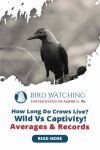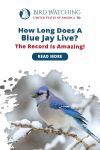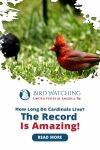
What’s this Post about?
Belonging to the Corvidae family of birds, crows are part of the Corvus genus. These medium-sized Blackbirds, measuring around 17 inches, are widespread throughout the world, ubiquitously found across all of the United States and parts of Canada, with the exception of Antarctica.
For the longest time, these birds have been castigated by humans due to their annoying habits – raiding crops, spreading mess, creating noise with their boisterous caws, and stealing eggs from the nests of other birds – all give the crows a noxious reputation. This may make one wonder, how long do these species live for?
A wild crow can generally live up to the age of 7-8 years, or even more if the environmental conditions are favorable. The longest living American crow in the wild has been recorded to be 29 years. Crows under captivity can live much longer, reaching an astounding record of 59 years.

What Is The Average Lifespan Of Crows?
Most birds in the Bird Kingdom typically live for a relatively brief lifespan, not living even for half as long as human life. Some species might only be able to live for just a few years, while others might live up to a decade or two. Birds kept in captivity have a longer chance of survival than those in the wild.

The life expectancy of crows largely depends on environmental factors, such as availability of food and nutrition, habitation and presence of predators.
In the Wild
Crows in the wild have been observed to have an average life expectancy of 7-8 years, having an average lifespan of 175 months. The oldest crow in the wild has been known to live for a record of 29 years.
In Captivity
Crows that live in captivity tend to have a longer lifespan than average. Even though there is a lack of authentic records found on the accurate age of the longest surviving crow in captivity, it is known to be 59 years of age.
RECORD!
A crow named Tata has been documented to live for 59 years old under captivity, dying in 2006.
What is the Habitat of crows?

Crows are known for their adaptability in diverse environments and can be found in a range of habitats across the world. These birds commonly inhabit the tidal flats, riparian forests, savannas, and many suburban areas.
They are commonly sighted foraging around in agricultural fields, orchards, and grasslands which serve as ideal sites to feed on grains, seeds, and nuts. Using the closely accessible forests and woodlands to roost during the night provides the crows with a comfortable habitat.
The survival of these species in the wild primarily depends on their ability to elude predators. To protect themselves from becoming a vulnerable target for predators, crows avoid dense forests where the raptors can easily capture them.
Gradually populating the urban and suburban zones where there is an abundance of the human population, crows have become common inhabitants of human settlements, thriving in parks, neighborhoods, and coastal areas in the cities. The crows tend to find their nesting and roosting sites closer to the locations where food is easier to find.
What do Crows eat?

These omnivorous species rely both on plants and animals to attain food. In the wild, these blackbirds would not only forage on the seeds, grains, nuts, and fruits, but tiny species such as insects, rodents, worms, and frogs also comprise their diets.
Preferring to feed in open areas, crows are opportunistic eaters, not being too finicky about their food choices and would feed on whatever is readily available. Crows are known for scavenging on the carrions and human garbage.
FUN FACT
Analogous to squirrels, crows would store their excess food for later use. They bury it in the ground or yard or hide it in the trees, covering it with foliage, reacquiring it in the time of need.
Adapting to diverse conditions, you would find huge murders of crows in places like the bird market, where these opportunistic birds can feed on a wide array of carrions, picking up the dead birds and abandoned eggs.
One of the favorite feeds of these black predatory birds is the seafood. For this reason, these dynamic birds can also be found close to the coastal regions, marshlands, tundra, and other water sources where they can get access to a multitude of seafood varieties.
Frequently visiting the garbage disposal sites, they examine the tons of litter to scavenge on dead animals and search for any possible remains of sea animals and meat in the trash.
Average Life Cycle of a Crow

Breeding and Nesting
Crows usually form monogamous pairs, forming lifelong bonds, but they often engage in promiscuous behavior, engaging in extra-pair copulations.
Once the male and female crows have paired together, they will begin building their nests in deciduous or evergreen trees. Crows typically choose the elevated, horizontal branches of the trees for their nests. Breeding and nesting season for crows begins in late March and April.
Life inside the Egg

After completing the nest, the female lays its clutch of eggs, typically between early May to June. The clutch usually comprises 3-8 eggs, having a light green base with slight, brown speckles.
The female takes up the incubation of the eggs for almost 18 days, after which the eggs hatch. During this period, the male crow becomes highly territorial, protecting the nest from any intrusions and bringing food for its mate.
Of the many laid eggs, not all can undergo successful incubation and hatch into chicks.
Nestling Stage

When the eggs hatch, young chicks, which are naked overall except for sparse tufts of greyish on the lower part of the body, come out. At the time of birth, these chicks are pretty clumsy, slowly beginning to develop.
They stay in the nest for around 28-35 days, where these little species are fed by their parent crows, bringing them food from dawn till dusk. The adult crows are assisted by other juveniles in rearing their young, usual nestlings from the previous breeding season.
A primary factor for the low survival rate of these tiny species is spontaneous predation. Predators such as snakes, raccoons, ravens, and cats are able to reach the nests of crows and gobble up the eggs or nestlings, despite the cautiousness of crows.
Fledgling Stage

When these fledglings are almost six weeks old, they learn to fly, gradually becoming professional aerialists. These fledglings might need the assistance of their parents to attain food for a few weeks until they become independent enough to survive on their own.
Unfortunately, fledgling crows have been recorded to have a mortality rate of 50% in the first year. Many of these young crows are not able to make it to the second year of their lives with their parents. They either die due to the sinister environment around them or get separated from their parents.
did you know?
It is immensely challenging for the young crows to survive their first year of independence. According to a study, only one in twenty crows are able to make it through this crucial stage!
Adult Stage

If these fledgling crows are successfully able to survive their first year of life and attain their sexual maturity, their probability of survival significantly increases. The chance that they would live for the next and subsequent years rises.
Quite apparent in their features, they develop scavenging and predatory skills, making it tough for the larger predators to attack and kill them.
These crows are known to attain sexual maturity at the age of two years, though these social species prefer to live in the same nests with their parents and other nestlings from subsequent breeding seasons for almost four to five years.
Do you wish to know whether these adult crows are dangerous enough to attack humans? Read this post!
Will Crows Attack or Hurt Humans? 5 Tips to Avoid It!
If you invade the personal space of crows, you can expect them to attack you. Read this post to find out how you can avoid crow attacks.
Factors Contributing To The Death Of The Crows

Even though crows are known to be one of the most intellectual birds, using their brainy minds to get out of difficult situations and resolve problems, they are unable to combat challenges that result in their untimely death.
A number of factors can be attributed to the relatively short lifespan of crows, both in the wild and the urban landscapes.
Predators

Crows themselves have conspicuous predatory traits, voraciously attacking smaller insects and birds and avidly snacking on them. However, as the cycle of nature goes, these birds also fall on the food web of some predatory species that are able to attack and kill the aggressive crows.
Though the eggs and young of the crows are extremely vulnerable to attacks from intruders, these attacks are less frequent in the case of adults. However, they still face potential threats from the fierce raptors such as the great horned Owl, Red-Tailed Hawk, Golden Eagle, and Peregrine Falcons.
In most cases, the crows mob together against their attacker and aggressively chase it away, but on rare occasions, may become a victim. Crows can also be attacked by bobcats and coyotes if they notice the incautiousness of crows and successfully launch a witty attack.
West Nile Virus

The species of crows are a vulnerable target of the West Nile Virus. Accidentally introduced in North America in 1999, it is believed that a bird was infected with the mosquito-borne African virus.
This has led to the demise of hundreds of crows, resulting in a 45% drop in the population of American crows since then. Being immensely susceptible to this virus, any crow that contracts this deadly virus is known to die within a week with minimal survival rates.
Birds of other species tend to have a higher mortality rate against this disease than crows. For this reason, crows are considered warden species, indicating the presence of the virus in a certain region or locality.
did you know?
The West Nile virus cannot be directly transmitted from crows to humans.
Unfortunately, crows are much reviled by humans due to their destructive habits, often considered an aggravation by many. The rapid loss of the bird population due to this virus has not led to significant protection concerns for the species.
Low Conservation Efforts

The shiny black plumage birds are widespread throughout most regions - with their populations incessantly rising. Having an extensive range and voluminous population, reaching almost 35 million, crows have a ‘least concern’ status in Wildlife conservation.
However, despite being protected under the Migratory Bird Treaty Act of 1918, humans have been making considerable efforts to partially, if not absolutely, eliminate these birds due to the nuisance they spread, creating ample noise, mess, and giving rise to diseases around.
The large murders of crows foraging on the agricultural fields have a detrimental impact on agriculture.
These birds have been killed in considerable numbers for decades, fed poisonous feeds to mitigate the adult and fledglings, and their nests have been widely displaced and destroyed, in campaigns to exterminate the crows, as well as to develop recreation sites, disencumbered by crows as they tend to scatter tons of garbage around.
Regardless of such stringent measures to drive away from the crows, they have not significantly impacted the population of crows that are thriving, still remaining ubiquitous aviating creatures.
DID YOU KNOW?
American Crows rank a 6 out of 20 on the Concern Continental Score.
Crows in Captivity

Even though restrictions have been imposed on hunting and capturing these birds under the Migratory Bird Treaty Act of 1918, many people keep the younger crows as pets, rearing them till they turn adults and often keeping them in captivity for the entire lifespan of the crow.
FUN FACT
American Crows are known to mimic human speech, and thus humans are fascinated to keep them as pets.
Crows also play a role in hunting games where they are hunted for sports and recreation when other commonly hunted birds cannot be captured.
Attracting Crows to your Yard

Despite the prevalence of crows in natural as well man-made habitats, including farms, landfills, parks, cemeteries, parking lots, highways, deciduous forests, shores of rivers and streams, they are not very frequent visitors to backyards.
The black, rivalrous birds, with their loud and raucous caws, are not a pleasure to have in the yard. But if you wish to attract them to your yard, invite these extraordinary brainy species by giving them a combination of trees, open space, and their favorite feed, such as peanuts, grains, fruits, and berries.
Keep in mind that if you have a garbage disposal site or composting area nearby, crows would be quite prevalent.

Keep Reading!
Having an average lifespan of around 7-8 years, crows are strenuous birds that can survive in a diversity of habitats, using their brilliant intellect to find ways of survival.
The young and eggs of the species, however, are highly susceptible to predatory attacks, having relatively low rates of survival, while the adults are able to withstand and combat attacks from any predators.
Not only are they widely known for their remarkable brains, but crows are highly adaptable species that have peculiar flying characteristics. If you want to know more about crows, read this blog to explore the common myths and superstitions associated with crows.
Are Crows Good or Bad Luck? Cultural Myths & Superstitions
Are you trying to find out whether crows are good or bad luck? Keep reading to find out more about some common cultural myths and superstitions.

By David A. Swanson
Bird Watching USA
My name is David and I'm the the founder of Bird Watching USA! I started Bird Watching with My father-in-law many years ago, and I've become an addict to watching these beautiful creatures. I've learnt so much over about bird watching over the years that I want to share with the world everything I know about them!

David A. Swanson
Bird Watching USA
My name is David and I'm the the founder of Bird Watching USA! I started Bird Watching with My father-in-law many years ago, and I've become an addict to watching these beautiful creatures. I've learnt so much over about bird watching over the years that I want to share with the world everything I know about them!








